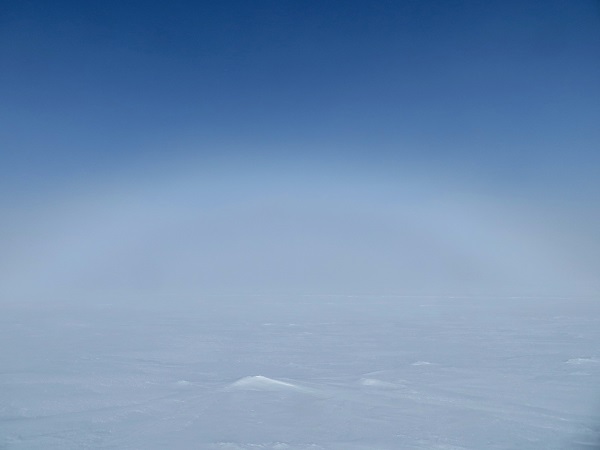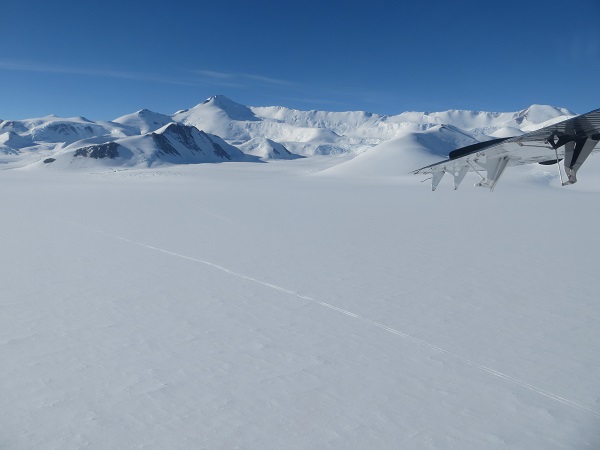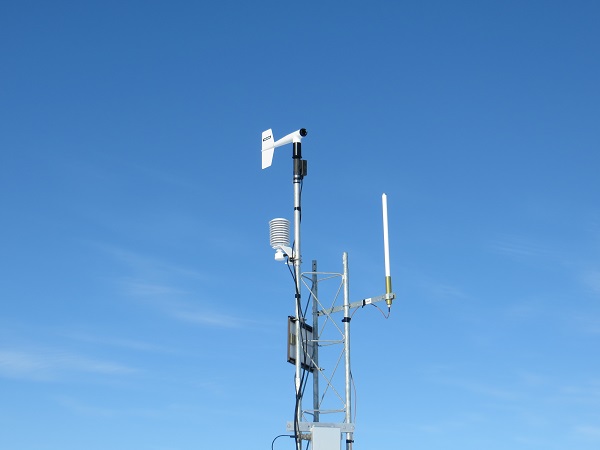The Twin Otter work continued on Wednesday 29 January, as Lee and I were scheduled to reinstall Tom AWS, the one we had removed on 24 January. This AWS was to be moved to a new location. In our communication with the Otter pilots and flight coordinators, we had been referring to this new site as “New Tom AWS.” As Lee, Melissa, John and I were discussing this Tuesday night, Melissa came up with the idea to rename the station Emma AWS, after her and Tom’s 1-year-old daughter (Tom AWS was named after Melissa’s husband). We talked it over with the rest of the AWS crew back in Madison and determined that the new location of the station was far enough from the original to warrant a new station name, as it would probably show some unique weather to the original.
So on Wednesday morning, Lee and I shuttled out to Pegasus. We took off at about 9:30 am. Our first destination was the WISSARD fuel cache on the far side of the Ross Ice Shelf from McMurdo. The fuel here is meant for flights like ours: a long journey to and from McMurdo that couldn’t be made without refueling. This area of the Ross Ice Shelf is notorious for having bad flying weather, typically in the form of low clouds and fog. This is exactly how it was when we landed.
These clouds make it very difficult, if not impossible, to see the snow surface when landing. Instead of risking that dangerous landing, we flew past the edge of the cloud bank and landed in clear skies, then taxied to WISSARD for about 5 miles. That’s a long way to taxi, but it’s much safer than the alternative. When we arrived, there wasn’t much to see.
Of course, there is usually more to see than initially meets the eye. As we were filling the plane up with fuel, I was taking in the foggy landscape. The sun was dulled by the clouds, and the sky and ground almost blended into each other. Looking away from the sun, the clouds were thinned out a bit, and I could see some of the sky. Looking exactly 180 degrees away from the sun, I saw the faintest of fogbows.

The very faint fogbow. I used a slight image enhancement to accentuate the feature, as it was difficult to capture on camera
We departed the cache and headed for the coordinates where we thought Emma AWS was to be installed. As we were flying, Lee and I noticed that we had started going over the Transantarctic Mountain range, rather than staying over the ice shelf and flying along the mountains. We thought this was weird, but put this thought aside and enjoyed the scenery.
It was just as breathtaking as it was when we flew over them after we removed Tom AWS.
We flew along a glacier valley and reached an area that had some flat fields of snow, indicating a potential landing sight. The pilots did some investigating before landing the plane for good, though. Since this was a sight that had no records of being landed in before, it was important to determine the characteristics of the snow surface. As we circled the area several times, we noticed some spots that obviously had crevasses; these areas are way too dangerous to land on. There was an area that appeared to be crevasse-free, but the snow surface still needed to be characterized. To do this, the pilots dragged the skis of the Otter along the surface. This allowed them to get a feel for how the Otter reacted to the snow and see what the tracks looked like.
After a couple ski-drags and a few more fly-arounds, we all decided that this wasn’t a safe place to land. Though that field we were testing may have been crevasse-free, the snow was far too soft. On our last ski-drag test, we noticed the Otter start to sink too deep into the snow as we slowed down. It may have been very difficult to take off again had we come to a complete stop and did a couple hours of work.
We turned around and headed back out to the ice shelf. Fortunately, Lee and I were prepared to do some planned work at Sabrina. The wind propeller wasn’t functioning, so we were going to replace it.
Upon arrival at Sabrina, it was pretty obvious why the wind propeller wasn’t functioning.
In addition to repairing the anemometer, we raised the lowest temperature sensor and replaced the data card.
We were on the ground at Sabrina for about an hour, and quickly got on the Otter and departed for the 3 hour flight back to McMurdo. It was a long, stressful day. It turned out that we had the coordinates for Emma AWS wrong by one degree latitude. It sounds insignificant, but it was the difference between landing on the sturdy, flat Ross Ice Shelf and attempting a landing on soft Transantarctic Mountain snow. There are two consolations to this mix-up: we were able to get to Sabrina AWS, and we still have just over a week’s time to get back out and install Emma AWS.
An Antarctic field season never ceases to surprise!
Cheers
Dave










